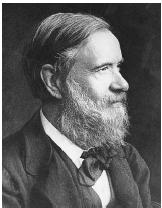Stanislao Cannizzaro

ITALIAN CHEMIST
1826–1910
Born in Palermo, Sicily, in 1826, Stanislao Cannizzaro began medical studies at the University of Palermo before moving to Pisa to study chemistry. However, when the Sicilian revolt broke out in 1848, Cannizzaro took part in the capture of Messina. The failure of the revolt forced Cannizzaro to flee to France, where he continued his studies in chemistry at the laboratory of Michel-Eugène Chevreul. In 1851, he returned to Italy and accepted a teaching position in Alessandro.
It was at Alessandro that Cannizzaro completed his studies of the reaction in which the action of alkali on benzaldehyde generates benzoic acid and benzyl alcohol, which came to be known as the Cannizzaro reaction. Further studies on the reaction revealed that it could employ any aldehyde without a hydrogen atom on the carbon closest to the carbonyl group.
Cannizzaro was a talented organic chemist and an early leader in the discipline, but it is his contribution to the then-existing debate over atoms, molecules, and atomic weights for which he is best known. He championed Amedeo Avogadro's notion that equal volumes of gas at the same pressure and temperature held equal numbers of molecules or atoms, and the notion that equal volumes of gas could be used to calculate atomic weights. In so doing, Cannizzaro provided a new understanding of chemistry.
During the early 1800s, many chemists were weighing in on atomic theory debates, including the debate over the actual, corporeal existence of atoms, with varying degrees of cogency. One difficulty arose from the fact that chemical formulas could be written in any one of a number of ways, if the atomic weights were unknown. For example, the formula for ordinary water, which we know is H 2 O, was often written "HO." Use of the latter formula required a belief that oxygen was only eight times as massive as hydrogen, and not sixteen times. The establishment of atomic weights was an important goal of chemists, as all chemical formulas were determined by ratios of elements, leading to empirical and not molecular formulas. Further, some of the leading chemists of the day had their own idiosyncratic theories on how atoms interacted, and there remained the belief that atoms did not actually exist.
In 1858 Cannizzaro published his "Sketch of a Course in Chemical Philosophy" in the journal Il Nuovo Cimento , in which he undertook to resolve many of chemistry's outstanding issues, basing his arguments on the work of Avogadro. Cannizzaro felt strongly that a consensus on these issues needed to be achieved. But the paper had little effect at the time of its publication. In 1860 August Kekulé, with the help of Adolphe Wurtz and Carl Weltzien, presided over the first international congress of chemists in Karlsruhe, Germany. Over 140 chemists, including Cannizzaro, attended the three days of discussion and debate. It was the organizers' hope that the congress would resolve some of the aforementioned issues. A participant posed the basic question: "Shall a difference be made between the expressions 'molecule' and 'atom' such that a molecule be named the smallest particle of bodies which can enter into chemical reactions … atoms being the smallest particles of those bodies which are contained in molecules?" (DeMilt, p. 38). Cannizzaro was present at the conference and spoke at length on virtually every subject that was debated.
Little was resolved at Karlsruhe. Still, in the words of attendee Dimitri Mendeleev, Jean-Baptiste-André Dumas made a brilliant speech proposing to use the new atomic weights only in organic chemistry, leaving the old for inorganic. Against this Cannizzaro spoke heatedly, showing that all should use the same new atomic weight . There was no vote on this question, but the great majority took the side of Cannizzaro.
It was after his departure from the conference that Cannizzaro finally made his point and settled the atomic weight debate. Angelo Pavesi, professor of chemistry at the University of Pavia and Cannizzaro's friend, distributed a pamphlet at the conference that contained Cannizzaro's 1858 "Sketch of a Course in Chemical Philosophy." The time was right for those in attendance to at last recognize that a systematic approach to atomic and molecular weights based on the work of Avogadro would resolve many of the outstanding disagreements. The Karlsruhe conference and Cannizzaro's paper are inevitably linked and represent a major turning point in our understanding of chemistry.
SEE ALSO Atoms ; Avogadro, Amedeo ; Chevreul, Michel ; KekulÉ, Friedrich August, Mendeleev, Dimitri ; Periodic Table .
Todd W. Whitcombe
Bibliography
Cobb, Cathy, and Goldwhite, Harold (1995). Creations of Fire: Chemistry's Lively History from Alchemy to the Atomic Age. New York: Plenum.
DeMilt, Clara (1965). "The Congress at Karlsruhe." In Selected Readings in the History of Chemistry , ed. Aaron J. Ihde and William F. Kieffer. Easton, PA: Division of Chemical Education of the American Chemical Society.
Ihde, Aaron (1964). The Development of Modern Chemistry. New York: Harper & Row.
Partington, J. R. (1989). A Short History of Chemistry. New York: Dover Publications.
Comment about this article, ask questions, or add new information about this topic: